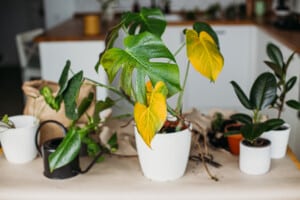The Arrowhead plant is an easy plant to care for as long as you give it lightly moist soil and bright light.
You are doing just that but suddenly you notice that the leaves are yellow. What caused this and how do you treat it? Or do you just throw it away and get a new plant?
The Arrowhead Plant
When the Arrowhead plant is young, the leaves are heart-shaped, and gradually as it matures, the leaves become arrowhead-shaped. The green leaves have cream or silvery-white variegation. Many find this to be a decorative houseplant that has become very popular in homes today. The Arrowhead plant has many varieties so you can choose one based on the size and color you want; Butterfly with creamy white veins on deep green leaves, or Imperial White with green leaves that are marbled with white. At this time, there are over 28 species distributed worldwide.
The young plants will form clusters of upright stems and as they develop, climbing stems will develop. They can grow to two feet tall and require bright light but not direct sun. The potting soil needs to be kept moist in the summer. These are perennial plants. Arrowhead plants are native to the tropical rainforests and like as much humidity as they can get.
Why Arrowhead Plants Gets Yellow Leaves
1. Moisture
This is the most common reason to find yellow leaves on your Arrowhead plant. There is improper soil moisture, which means the plant has been overwatered. You should only water it when the top 50% of the soil is dry. When the leaves start to slightly wilt, you know it is time to water your plant. Your Arrowhead plant does not respond well to “wet feet.” This can lead to root rot and eventual death for the plant. Yellow leaves are the first sign. Also, if you alternate between wet soil and bone dry from improper watering, it can create stress on the plant and the leaves will turn yellow.
2. Humidity
Dry soil and low humidity can cause the leaves to start to brown on the edges, droop, and then followed by the entire leaf turning yellow, brown and shriveling up.
3. Wrong lighting
If they are exposed for too long to direct sunlight, the foliage will burn and the leaves will turn yellow. Although they can adapt to low light, yellow leaves may develop and the growth could slow down.
4. Pests
If your plant is stressed or weakened, it is more susceptible to insect infestations of insects such as mealy bugs, spider mites, and scale. The spider mites are sap-sucking insects so they can quickly drain the Arrowhead plant of moisture. This will appear as yellow leaves and fronds. The piercing mouths of these different insects can exhaust your plant causing yellow leaves also. The mealy bug likes to get deep in the new growth. Because the Arrowhead plant is so dense it is a great place for the bugs to hide.
5. Nitrogen deficiency
Sometimes, if your Arrowhead plant is not getting enough nitrogen, especially the mature foliage, the leaves could start to turn yellow.

Treatment
Moisture
You should only water your plant until the water drains from the hole at the bottom of the plant. If it is sitting on a saucer, you need to discard any excess water in there. You cannot let your plant sit in any standing water. You need to make sure that you are giving the proper consistent soil moisture for your Arrowhead plant to help prevent root rot and less stress on the plant. You can also check your soil for over-or-under watering by sticking your finger in the potting mix. It is too wet if it is soggy or if it is dry an inch below the top, it is too dry. This will help you know how to treat it.
Humidity
When there is low humidity, you can purchase a humidifier or mist the leaves every day. You can also put some pebbles on a tray and cover them halfway with water. Set the plant on top of the pebbles. As the water evaporates it will add humidity to the room.
Similar post: Yellow Aglaonema Leaves
Wrong lighting
Do not put your Arrowhead in direct sunlight or low light. Keep it in bright indirect sunlight.
Pests
You can get rid of these insects by wiping off the leaves with a wet cloth or use a cotton ball that has been dipped in alcohol. For mealy bugs, you can just blast them off lightly in the kitchen sink or bathtub with the spray. Do not let the water spray hit the plant too hard. You need to kill them early before they move into the nooks and crannies of the plant. You also need to make sure that you keep your plant healthy so it is easier to get rid of the insects. They can also travel from plant to plant so that is why you need to get rid of them.
Also read:
Nitrogen deficiency
To take care of this issue, you will need to apply to the plant an all-purpose, houseplant fertilizer. Make sure it is at half-strength what the instructions call for.
Conclusion
It is only natural that your plant will sometimes have yellow leaves. The reason is that the yellow leaves are the older ones, especially at the bottom of the plant. They turn yellow because they are shedding their old years and new growth is coming in. When the old leaves are being shed, it is sending energy to the new growth.
So, if you see yellowing leaves, you need to make sure that it has the right soil moisture, it is not infected with insects, and it has the right light. If all of this okay then it is most likely older leaves making room for the new growth. The Arrowhead plant can be used as a plant to sit on tables, in dish gardens, or as hangers. They are generally fast growers but in the winter they will grow slower.
More like this:
Victoria is the owner and main author of hobby plants. She loves spending her free time in her garden planting and taking care of her plants. Victoria hopes you enjoy the content here!



![Why Are My Orchid Leaves Turning Yellow? [Find Out Here] Why Are My Orchid Leaves Turning Yellow? [Find Out Here]](http://54.201.156.32/wp-content/uploads/2022/07/orchid-leaves-turning-yellow-300x158.jpg)
![Why Is My Bamboo Plant Turning Yellow? [Find Out Here] Why Is My Bamboo Plant Turning Yellow? [Find Out Here]](http://54.201.156.32/wp-content/uploads/2022/07/why-is-my-bamboo-turning-yellow-300x158.jpg)
![Why Is My Fiddle Leaf Fig Dropping Leaves? [ANSWERED] Why Is My Fiddle Leaf Fig Dropping Leaves? [ANSWERED]](http://54.201.156.32/wp-content/uploads/2022/06/why-is-my-fiddle-leaf-fig-dropping-leaves-300x158.jpg)
![Why Are My Bird of Paradise Leaves Curling? [FIND OUT HERE] Why Are My Bird of Paradise Leaves Curling? [FIND OUT HERE]](http://54.201.156.32/wp-content/uploads/2022/07/bird-of-paradise-leaves-curling-300x158.jpg)
![Why Are My Peace Lily Leaves Turning Brown? [EXPLAINED] Why Are My Peace Lily Leaves Turning Brown? [EXPLAINED]](http://54.201.156.32/wp-content/uploads/2022/07/peace-lily-leaves-turning-brown-1-300x158.jpg)

![Mother Of Thousands Plant [Complete Plant Care Guide] Mother Of Thousands Plant [Complete Plant Care Guide]](http://54.201.156.32/wp-content/uploads/2022/07/mother-of-thousands-plant-300x158.jpg)

